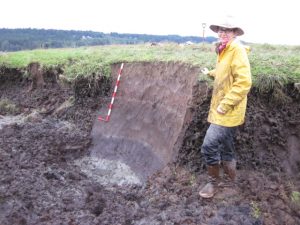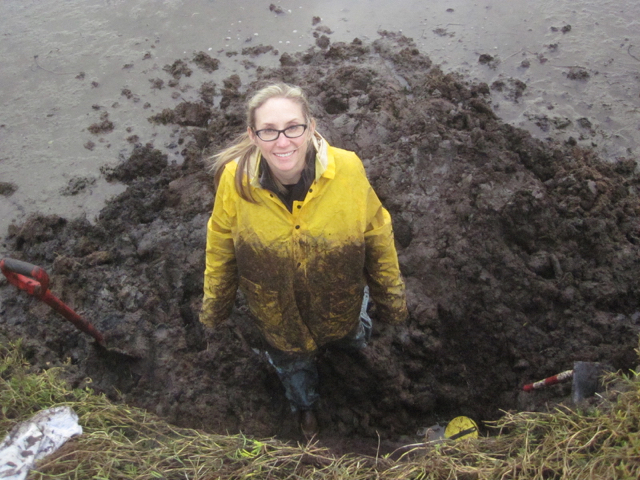 Abstract: My research seeks to determine where Cascadia tsunamis been recorded in Puget Sound tidal marshes; and what environmental changes, if any, occurred in these tidal marshes in response to coseismic and/or postseismic deformation from great earthquakes on the Cascadia Subduction Zone.
Abstract: My research seeks to determine where Cascadia tsunamis been recorded in Puget Sound tidal marshes; and what environmental changes, if any, occurred in these tidal marshes in response to coseismic and/or postseismic deformation from great earthquakes on the Cascadia Subduction Zone.
The extent that Cascadia earthquakes and tsunamis affect Puget Sound is relatively unknown. I will use diatom paleoecology and sedimentology to study two types of evidence. First, I will identify tsunami deposits preserved in Puget Sound tidal marshes. Second, I will determine whether or not Puget Sound tidal marshes record land-level change that coincided with, or shortly followed, great Cascadia earthquakes.
Report: During the summer of 2015, I continued my study of Puget Sound tidal marshes for evidence of seismic hazards from the Cascadia subduction zone. I focused on the record of tsunami deposits in Puget Sound that I hypothesize are from the subduction zone.
I worked at sites in Hood Canal (Lynch Cove), Discovery Bay, and Port Townsend Bay. I refined the dating for tsunami deposits from Lynch Cove and Discovery Bay by collecting and submitting additional radiocarbon samples, and these new dates have narrowed the timing of the tsunami events at both sites. In particular, the ages of the tsunami deposits at Discovery Bay are poorly constrained, so narrowing the age ranges helps with comparisons to the record at Lynch Cove, evidence for subduction zone earthquakes from the outer coast of Washington, and other future sites with tsunami deposits.
At both Lynch Cove and Discovery Bay, I also worked with personnel from the Washington Department of Natural Resources, refining the use of Ground Penetrating Radar in order to trace the tsunami deposits in the subsurface. The method was successful, and the findings were presented at the fall American Geophysical Union (AGU) meeting in December 2015. I was a coauthor on the presentation.
 Other fieldwork completed included describing potential new tsunami deposits at Port Townsend Bay. I used recent tsunami simulations that predict high water “hot spots” for several sites in Puget Sound to search for historically undisturbed marsh sites that may preserve tsunami deposits. I explored several promising marshes without finding sand layers, but I did find two sand layers that are likely tsunami deposits in a marsh at the south end of Port Townsend Bay. I have radiocarbon samples from these layers awaiting dating with expected USGS funding.
Other fieldwork completed included describing potential new tsunami deposits at Port Townsend Bay. I used recent tsunami simulations that predict high water “hot spots” for several sites in Puget Sound to search for historically undisturbed marsh sites that may preserve tsunami deposits. I explored several promising marshes without finding sand layers, but I did find two sand layers that are likely tsunami deposits in a marsh at the south end of Port Townsend Bay. I have radiocarbon samples from these layers awaiting dating with expected USGS funding.
I collected new modern diatom samples to add to the regional modern diatom database that will be used for sea level reconstruction at Lynch Cove in early 2016. I purchased a salinity meter with funds received from the QRC to help with characterizing these modern samples. I used modern and fossil diatoms to confirm that the tide flat next to the marsh at Lynch Cove is the likely source of the sediments in the tsunami deposits at Lynch Cove.
I forged a new collaborative relationship with professors Randy LeVeque and Loyce Adams, Department of Applied Mathematics, University of Washington. They developed GeoClaw software to model tsunami simulations, and they created new simulations of the Hood Canal area that show water heights of 5+ meters at Lynch Cove for a Cascadia tsunami. In addition, they have agreed to train me to use GeoClaw, so I can learn to model other sites to complement my tsunami hazard research.
I traveled to San Francisco and presented my Lynch Cove tsunami research findings at the annual AGU meeting on Dec 15th. My work was well-received, and my talk resulted in multiple discussions with out of state and international workers, as well as invitations to collaborate with others doing complementary work.

 Other fieldwork completed included describing potential new tsunami deposits at Port Townsend Bay. I used recent tsunami simulations that predict high water “hot spots” for several sites in Puget Sound to search for historically undisturbed marsh sites that may preserve tsunami deposits. I explored several promising marshes without finding sand layers, but I did find two sand layers that are likely tsunami deposits in a marsh at the south end of Port Townsend Bay. I have radiocarbon samples from these layers awaiting dating with expected USGS funding.
Other fieldwork completed included describing potential new tsunami deposits at Port Townsend Bay. I used recent tsunami simulations that predict high water “hot spots” for several sites in Puget Sound to search for historically undisturbed marsh sites that may preserve tsunami deposits. I explored several promising marshes without finding sand layers, but I did find two sand layers that are likely tsunami deposits in a marsh at the south end of Port Townsend Bay. I have radiocarbon samples from these layers awaiting dating with expected USGS funding.